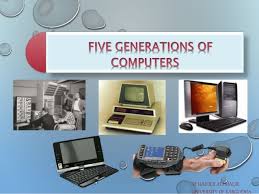The Generations Of Computers
{tocify} $title= {Table
of Contents}
The Generations of Computers
“Generation” in computer terminology is a step in technology .It provides a framework for the growth of the computer industry. Initially, the generation term was used to distinguish between varying hardware entire computer system. How Computers operate – leading to more compact, less expensive, but more powerful, efficient and robust machines. The custom of referring to the computer era in
terms of generations came into wide use only after 1964. There are totally five
computer generations known until today. Each generation has been discussed here.
The custom of referring to the computer era in
terms of generations came into wide use only after 1964. There are totally five
computer generations known until today. Each generation has been discussed here.Figure of Electronic Devices used for Manufacturing Computers of
Different Generations
Five Generations Of Computers Are AS Following:
1.
First-generation: Vacuum Tubes (1942-1955).
2. Second-Generation: Transistors (1955-1964).
3. Third-Generation: Integrated Circuits (1964-1975)
4. Fourth-Generation: Microprocessors (1975-1990)
5. Fifth Generation: Artificial Intelligence
(1990 - Onwards)
The following technology definitions will help you to better
understand the five generations of computing:
·
computer
·
microprocessor
·
magnetic drums
·
binary
·
integrated circuit
·
semiconductor
·
nanotechnology
·
machine language
·
assembly language
·
artificial intelligence

In
details along with its identifying each characteristics. Brief descriptions each generation of computers
have their features, advantages and disadvantages, and examples of each
describes of another next articles of in this blog www.sbgtutorials.blogspot.com











